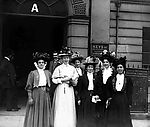 Women's Trade Union League leaders 1902
Women's Trade Union League leaders 1902 Mrs Emma Patterson, founder of the W.T.U.L.
Mrs Emma Patterson, founder of the W.T.U.L. Mary addressing a strike meeting of box-workers 1908
Mary addressing a strike meeting of box-workers 1908 Mary at Trade Union Congress in Nottingham 1908 (second from left)
Mary at Trade Union Congress in Nottingham 1908 (second from left)

The Women's Trade Union League was established by Mrs Emma Patterson in 1874. She had visited America, and was impressed with the women's unions there. When she returned, she formed the Women's Protective and Provident League with the aim of setting up unions in every trade employing women. It changed its name to the Women's Trade Union League in 1903, the same year that Mary Macarthur became its general secretary.
The League was not a trade union itself but acted as a Trade Union Congress (T.U.C.) for unions with women members. It was supported partly by donations from people who agreed with trade unionism, and partly by affiliation fees. The fees were kept low, so that smaller and poorer unions would not be excluded.
Mary joined the League as its secretary at a difficult time. It was struggling to get women to join unions, and its funds were low. Mary's biographer, Mary Agnes Hamilton, wrote, "If they were not sure at first that they wanted so powerful a blast through their organisation, they were soon to be conquered both by results and by the sun behind the storm." (Hamilton, 1925, p31). Mary did not wait for unions to join, she went out to make them join.
Mary quickly built up the bank balance and the membership. In two years 14,000 new members joined the League, increasing the total to over 70,000.
Even though the League's finances were better, it still did not have sufficient funds to support a strike, as Mary found out in 1906, during the jute workers dispute in Dundee. Mary had wired Gertrude Tuckwell, the League's president, for £100 to keep the women out on strike. Miss Tuckwell was unable to raise the money and the strike failed. It was this incident that led Mary to form the National Federation of Women Workers (N.F.W.W.). The aim was to combine smaller unions into one large general union, which would generate more money and be able to build a larger strike fund.
Mary became secretary of the N.F.W.W., but also carried on as secretary of the League. It campaigned with the Anti-Sweating League to establish Trade Boards and a minimum wage. The Women's Trade Union League was absorbed into the T.U.C. in 1921, the same year as Mary's death.
Rollover the captions in the box to see the available images in thumbnail format, click the caption to see the full-size image
| Reference: | 713 |
| Keywords: | |
| Archive Ref: | |
| Updated: | Thu 12 Jul 2007 - 0 |
| Interpretation written by | Barbara Harris |
| Author's organisation | |
| Organisation's website |